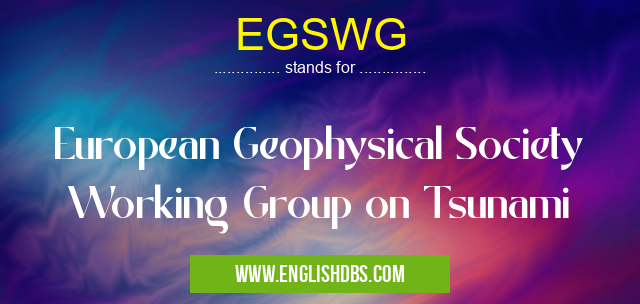What does EGSWG mean in OCEAN SCIENCE
The European Geophysical Society Working Group on Tsunami (EGSWG) is an international body of scientists and experts dedicated to the study and understanding of tsunamis and their impacts. The group acts as a focal point for the exchange of scientific knowledge, ideas and methodologies in order to help better predict and manage tsunami risk. Its aim is to provide timely information to improve the safety of citizens, societies and coastal communities located in high-risk areas across Europe.

EGSWG meaning in Ocean Science in Academic & Science
EGSWG mostly used in an acronym Ocean Science in Category Academic & Science that means European Geophysical Society Working Group on Tsunami
Shorthand: EGSWG,
Full Form: European Geophysical Society Working Group on Tsunami
For more information of "European Geophysical Society Working Group on Tsunami", see the section below.
What it does
The EGSWG has the important task of promoting research related to tsunami hazard assessment, coastal zone management, risk communication strategies, early warning systems, and socio-economic implications of tsunamis. It is involved in organising international conferences and seminars regarding tsunamis; establishing contacts with other bodies worldwide dedicated to tsunami research; providing information about tsunamis through its website as well as various publications; and disseminating new scientific findings concerning tsunami risks via its newsletter 'Tsunami Waves'. In addition, the group strives to provide assistance during times of crisis by responding rapidly with an organized action plan which includes monitoring any regional tsunamis that might threaten or occur within Europe or neighbouring regions.
Essential Questions and Answers on European Geophysical Society Working Group on Tsunami in "SCIENCE»OCEAN"
What is a Tsunami?
A Tsunami is a natural disaster that occurs in water bodies such as the ocean, caused by movements of the Earth's crust. It is characterized by large waves which cause destruction in coastal regions.
What distinguishes a tsunami from other waves?
The function that distinguishes tsunamis from regular ocean waves is their long wavelength, which makes them more powerful and destructive when they reach shore. Tsunamis are also distinguished by their speed: they can travel much faster than regular ocean waves and reach speeds of up to 800 km/h near shorelines. This rapid speed can cause devastating damage when they reach land.
What causes tsunamis?
Tsunamis are typically caused by large and sudden displacements of the seafloor due to earthquakes, landslides or volcanic eruptions. These events create a disturbance in the water column which then travels outwards, generating giant waves that can travel across entire oceans.
How can we detect tsunamis?
Tsunamis can be detected using seismic stations that measure ground movement, sea level gauges that monitor sudden changes in sea level and high-frequency radiowave systems known as Deep-ocean Assessment and Reporting of Tsunamis (DART). DART systems consist of seabed buoys with pressure sensors connected to an onshore station via satellite communication lines. By combining data from these sources, it is possible to detect incoming tsunami threats in advance.
What measures should be taken after a tsunami warning has been issued?
After a warning has been issued, people should evacuate areas at risk of flooding immediately, before moving inland away from the coast and any riverside areas. People should not wait for an official evacuation order as this may come too late once the wave arrives. People should also refrain from travelling to affected areas until local authorities say it's safe to do so.
How large can tsunamis get?
The size of a tsunami depends largely on its source — for example, large underwater earthquakes or megathrusts will produce larger tsunamis than smaller ones due to their greater energy output. Generally speaking though, tsunamis usually range between 3 - 10m in height but there have been occasions where tsunamis have reached higher heights ranging up to 40m or even more when generated near coasts with shallow waters near continents or islands (e.g off Chile).
Are there different types of tsunamis?
Yes - aside from the typical ‘single wave' type generated by most earthquakes and submarinelandslides, there are two other types known as ‘doublets' and ‘multiplets' formed when multiple seismic events occur close together in time (within minutes). In addition, some multiplets have also been known on occasion to generate huge cascading water walls called ‘dynamic tsunami runup'.
Final Words:
The mission of the European Geophysical Society Working Group on Tsunami (EGSWG) is essential for providing critical knowledge and resources which can be used towards reducing the impacts from future tsunami events. Through research, publications, conferences and working with other organisations, this vital organisation plays a key role in ensuring safety and security along Europe's coasts.
